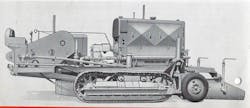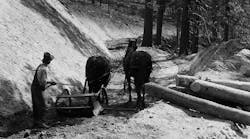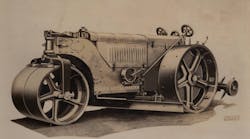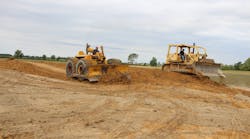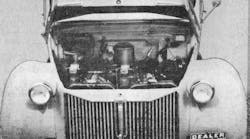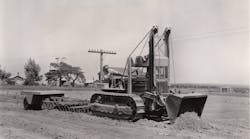Given the technology available at that time, there were two ways of mechanizing an asphalt paving project in the early 1930s: mixing it at a batch plant and placing it with a grader or form-riding spreader; or road mix, in which aggregates and hot oil were blended together on the roadbed by repeated passes of a grader.
Blade mixing was less expensive than plant mix, but the results were uneven. Each bit of aggregate had to be coated with oil, and this was often difficult with a grader. A means of producing better quality roadmix more quickly and more economically was needed, and travelling pugmills were developed in the early 1930s.
Madsen Iron Works was established in southern California in 1910, and had been building pugmill asphalt plants since about 1915. In the early 1930s, Madsen began development of its Road Pug roadmixer. Unlike its competitors, it was self-propelled and fully self-contained, and did not require a separate power source. It maneuvered like a crawler tractor, and for good reason—it was essentially a cross between a pugmill and a crawler tractor, using Caterpillar assemblies.
After the roadbed had been scarified and shaped to the desired profile, the aggregates were windrowed at 3 to 10 cubic feet per lineal foot. A uniform windrow was critical to providing an even flow of material into the mixer. The mixer was hydraulically tilted to a roughly 9 degree working angle to engage the cutting blade with the subgrade. Two converging moldboards formed a cutting blade to gather aggregate and direct it into the mixer. The front paddles on the mixer’s two longitudinal shafts dry-mixed the aggregates, and the rest cross-mixed the aggregates with oil fed from a trailer pulled by the Road Pug.
The mix was densified and spread by a discharge gate with pressure controlled through a counterweight; the gate restricted movement of mix through the mixer and consolidated it on the same principle as balling material in one’s hand.
The Road Pug worked at 5 to 40 feet per minute depending on the type of aggregate and the mix specifications, and could mix 1,500 to 4,000 tons per 8 hours.
As asphalt pavers were perfected, road mix asphalt paving fell out of favor. A batch plant produced material faster with full control of the volume and quality of aggregates without reliance on the skills of a blade man or watching for fines, and the plant’s dryer solved problems of moisture in the aggregate that could shut down a roadmix job. Roadmix still had to be bladed before compaction, whereas a paver spread asphalt ready for rolling. All these advantages resulted in much less time and traffic disruption to perform the work.
The Historical Construction Equipment Association (HCEA) is a 501(c)3 non-profit organization dedicated to preserving the history of the construction, dredging and surface mining equipment industries. With over 3,800 members in 25 countries, our activities include publication of a quarterly educational magazine, Equipment Echoes, from which this article is adapted; operation of National Construction Equipment Museum and archives in Bowling Green, Ohio; and hosting an annual working exhibition of restored construction equipment. Our 2019 show will be September 13-15 at our Museum in Bowling Green, Ohio. Individual memberships within the U.S. are $35 for one year, $66.95 for two years and $99.95 for three years. We seek to develop relationships in the equipment manufacturing industry, and we offer a college scholarship for engineering and construction management students. Information is available at www.hcea.net, or by calling 419.352.5616, or emailing [email protected].
